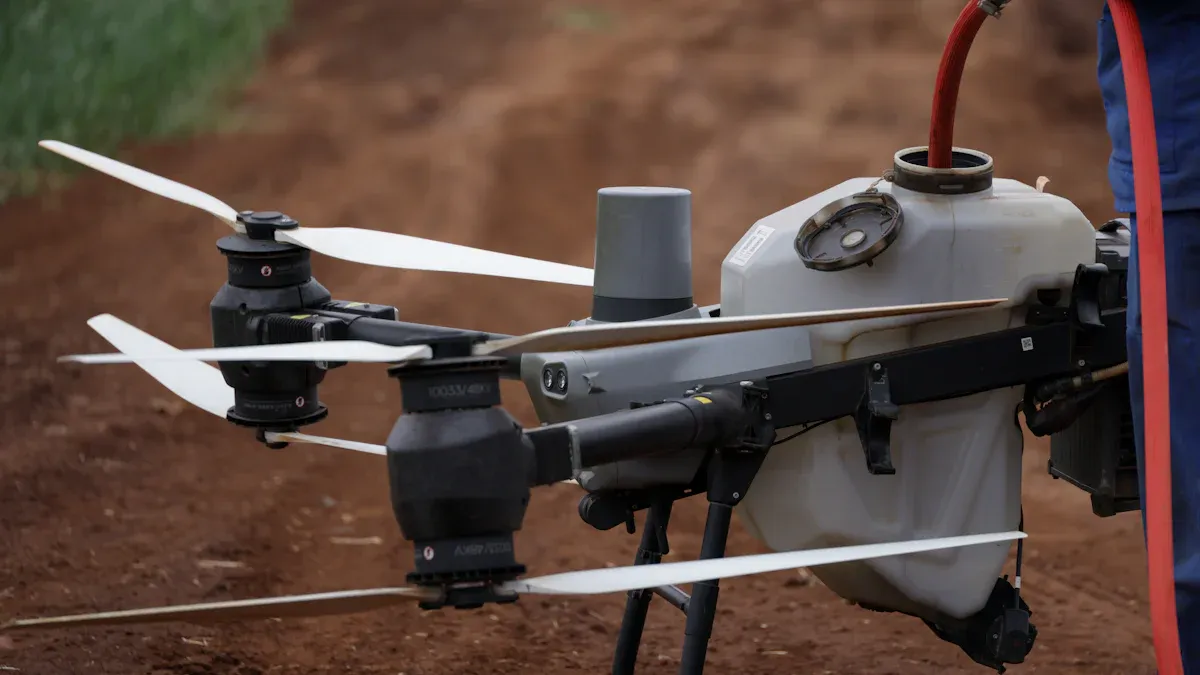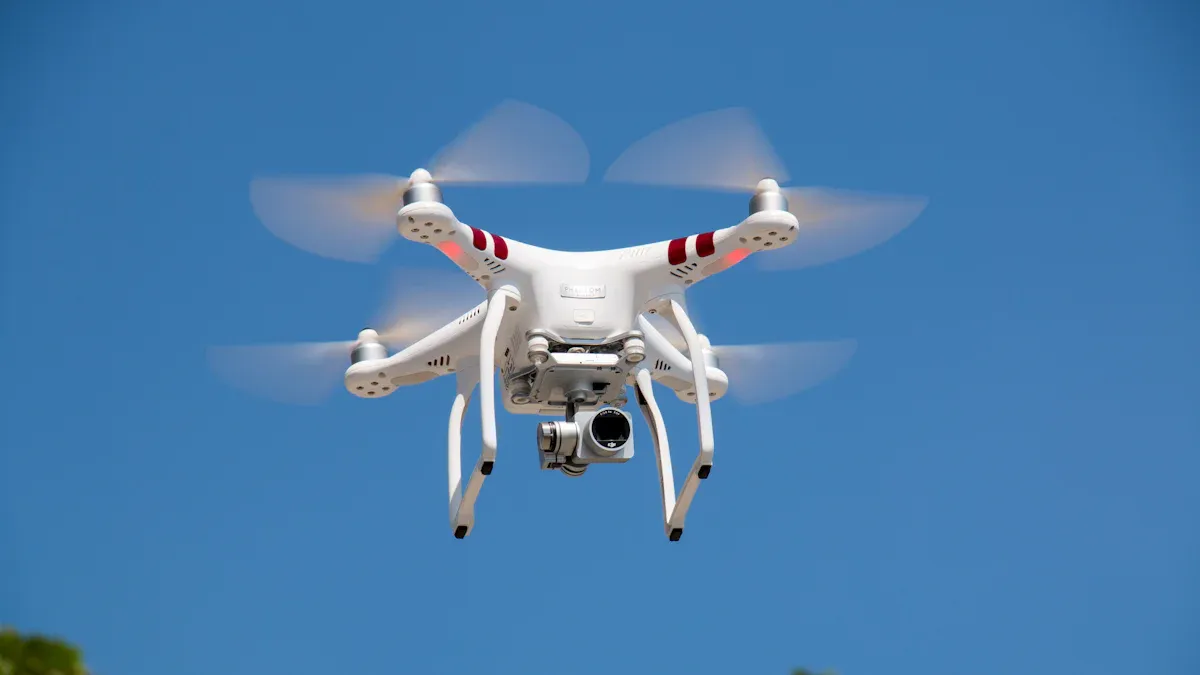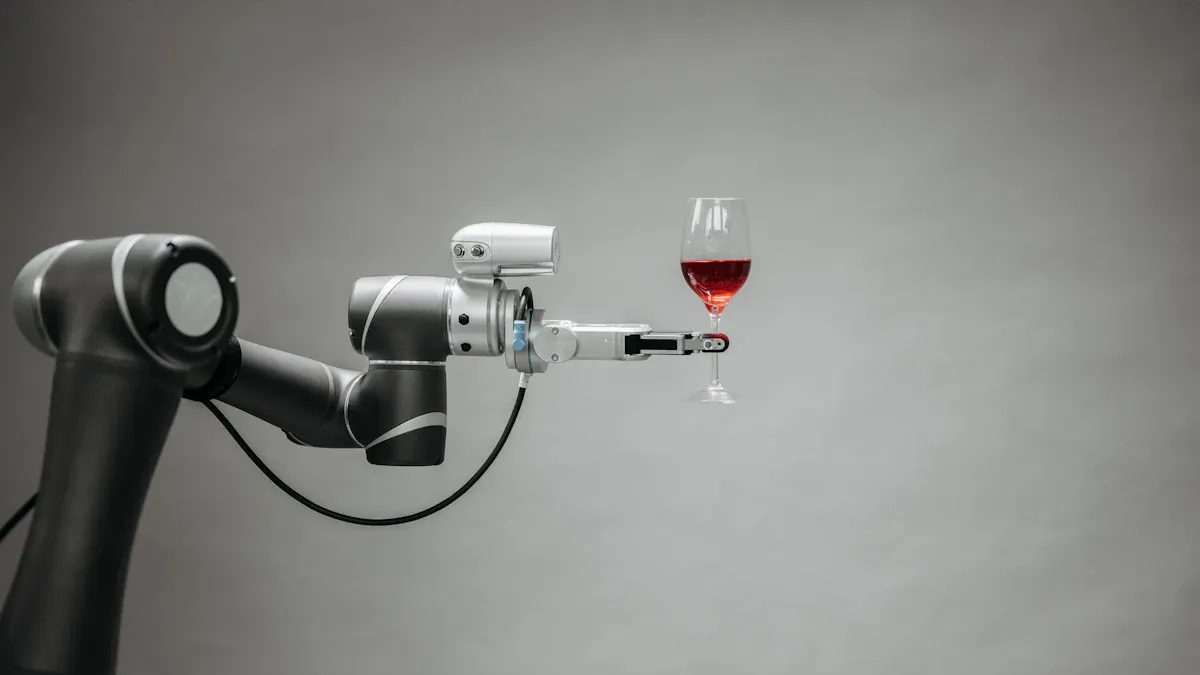The ethics of unmanned delivery drones in retail logistics

You probably wonder if unmanned delivery drones are truly ethical for retail logistics. Many people feel excited about fast, high-tech deliveries, but real worries exist. Safety, privacy, and environmental issues matter to you and your community. The drone market grows fast, with 14,000 daily deliveries in 2024 and millions more expected soon:
Year | Daily Deliveries | Total B2C Deliveries (millions) |
|---|---|---|
2024 | 14,000 | 5 |
2034 | N/A | 808 |
The growing debate over drone surveillance privacy highlights serious ethical concerns. Critics warn that widespread deployment of autonomous aerial monitoring could blur the line between legitimate security and invasive surveillance.
You must balance the benefits of new technology with the risks it brings.
Key Takeaways
Unmanned delivery drones offer fast service but raise safety concerns. Weather, technology failures, and public trust are key factors to consider.
Privacy issues are significant with drone deliveries. Many people worry about being watched or having their data misused, so companies must be transparent about data handling.
Drones can reduce greenhouse gas emissions compared to traditional delivery methods. However, companies must manage electronic waste responsibly as drone batteries have a limited lifespan.
Community engagement is crucial. Companies should communicate openly about safety measures and address public concerns to build trust.
Understanding local regulations is essential. Different areas have varying rules for drone operations, impacting how and where drones can be used.
Ethical Concerns
Safety
You face important questions about the safety of unmanned delivery drones in your neighborhood. These drones promise fast and efficient deliveries, but they also bring new risks. You need to think about how weather, technology, and public trust affect their safe use.
Description | |
|---|---|
Weather Dependency | Drones are affected by weather conditions such as strong winds, rain, snow, or extreme temperatures, which can disrupt service reliability. |
Privacy and Security Risks | Drones equipped with cameras raise concerns about surveillance and data privacy, and they are also vulnerable to cybersecurity threats. |
Public Trust and Perception Issues | Many people are still uncomfortable with drones due to concerns about noise, safety, and potential malfunctions, affecting their acceptance. |
You might worry about drones flying in bad weather. Strong winds or heavy rain can cause accidents or delays. Drones can also malfunction or lose control, which could lead to injuries or property damage. Many people feel uneasy about drones flying overhead, especially when they do not know how safe the technology is. Companies must take responsibility for safety. They need to follow strict rules, monitor their drones, and share information about how they keep you safe. When you see clear safety protocols and open communication, you can feel more confident about this new technology.
Privacy
Privacy stands out as one of the biggest concerns with unmanned delivery drones. You may feel uneasy when drones fly over your home or neighborhood. Many people worry about being watched or recorded without their consent. The lack of clear federal rules about drone flights over residential areas adds to these fears.
Many individuals worry that delivery drones could be used as a form of widespread surveillance, leading to a sense of constant observation and loss of privacy in both public and private spaces.
Concerns exist regarding how the data collected by drones might be used, including questions about access, storage, and potential sale to third parties.
The ability of drones to access previously private areas, such as backyards or balconies, raises issues of potential trespassing and intrusion.
"Privacy is the most commonly heard concern regarding the use of commercial and recreational drones. The FAA requires registration of UASs but does not regulate flight patterns. According to Dr. Ryan Wallace, assistant professor of Aeronautical Science at Embry-Riddle Aeronautical University, 'So long as the UAS operator is compliant with operational restrictions, there are no federal restrictions regarding overflight of residential areas.'"
You need to know how companies handle your personal data. Most privacy rules for drones follow general digital privacy laws, not specific rules for unmanned delivery drones. This gap means your information might not have enough protection. Companies can build trust by being open about what data they collect, how they use it, and who can access it. They should also work with regulators and keep you informed about their privacy practices.
Balancing Innovation and Responsibility
You want the benefits of fast, modern delivery, but you also want to feel safe and respected. Companies must balance innovation with responsibility. They should:
Share clear information about flight paths, delivery times, and safety measures.
Take responsibility for any accidents or privacy breaches.
Engage with you and your community to address concerns.
Monitor their operations and improve them based on feedback.
Work closely with regulators to follow all laws and standards.
When companies act with transparency and care, you can enjoy the advantages of unmanned delivery drones while feeling secure about your safety and privacy.
Unmanned Delivery Drones: Impact

Environment
You might wonder how unmanned delivery drones affect the environment. These drones use batteries instead of gasoline or diesel. Research shows that small drones can cut greenhouse gas emissions by up to 50% per package compared to diesel trucks in California. Across the United States, the average reduction is about 37%. Even in places with less clean electricity, like Missouri, drones still lower emissions by 23%. The amount of emissions depends on how far the drone travels, how much energy it uses, and how many packages it delivers.
However, you should also think about electronic waste. Drone batteries do not last forever. Companies must manage old batteries and other parts. The drone industry has increased recycling and reuse programs by 40% in 2023. Eco-friendly batteries now make up 35% of the market. Drones can even help track and manage e-waste, making the process more efficient.
Evidence Type | Description |
|---|---|
E-waste Growth | Large companies generate more e-waste, which is harder to manage. |
Drone Efficiency | Drones help track and monitor e-waste, improving management. |
Recycling Increase | Recycling and reuse programs grew by 40% in 2023. |
Economy
Unmanned delivery drones change the way you receive packages. They can lower costs for businesses by reducing the need for human drivers. This means companies save money on labor. However, some delivery jobs may disappear. Workers may need to learn new skills or find different jobs.
Aspect | Description |
|---|---|
Cost Savings | Drones reduce the need for human drivers, lowering labor costs. |
Job Displacement | Automation may cause job losses for traditional delivery workers. |
Small businesses can benefit from drones. Drones deliver packages quickly and avoid traffic. This helps small shops compete with big retailers. Drones also make returns faster and cheaper. Businesses save money on fuel and vehicle repairs. Drones can reach remote areas, giving small businesses more customers.
Society
Unmanned delivery drones affect people in different ways. In cities, people often accept new technology faster. They have better internet and roads, so drones work well. In rural areas, people may feel unsure about drones. They may not have the same resources or trust in new technology.
Urban residents often have higher education and income, leading to greater acceptance of drones.
Rural areas may lack good infrastructure, making drone use harder.
Cultural differences affect how quickly people accept drones.
Younger people and women often like drone deliveries more. As you see drones more often, you may feel more comfortable with them. Many people believe drones help the environment and make life easier.
Regulation and Security

Laws
You need to understand how laws shape the use of unmanned delivery drones in retail logistics. Rules differ across countries and even within regions. In the United States, you see two main types of drone permits. The Part 108 Operating Permit allows drones up to 55 pounds in less crowded areas. The Part 108 Operating Certificate covers drones up to 110 pounds and lets them fly in all areas, including cities. The review for the certificate is more thorough.
Authorization Type | Maximum Drone Weight | Population Density Categories Allowed | Oversight Level |
|---|---|---|---|
Part 108 Operating Permit | 55 pounds | Category 3 or lower (suburban) | Less thorough review |
Part 108 Operating Certificate | 110 pounds | All categories (including urban) | More thorough review |
You see that Europe uses a different system. The SORA framework lets operators assess risks for each flight. Europe divides drone operations into Open, Specific, and Certified categories. Australia, Canada, and Brazil are building similar systems. In Africa and Asia, some countries like Rwanda set up special delivery corridors for drones. These differences mean companies must follow many rules, and global standards are still developing.
Safety and minimal disturbance matter everywhere. Early talks with regulators help companies avoid problems.
Recent executive orders in the U.S. make drone rules clearer. The idea of "Beyond Visual Line of Sight" is important for commercial deliveries. Many people worry about drones disturbing neighborhoods. Over half of surveyed Americans do not support expanding airspace for drone deliveries. Local law enforcement faces limits in managing drone threats, showing gaps in current laws.
Cybersecurity
You need to know how companies protect drones from hackers. Drones face risks like weak passwords, old software, and insecure data channels. Hackers can take control, steal data, or invade privacy.
Drones are vulnerable to hacking if companies do not secure them.
Weak credentials and outdated firmware make attacks easier.
Insecure telemetry channels can lead to data leaks and loss of control.
Companies use several tools to keep drones safe. Secure components help block attacks. Virtual Private Networks (VPNs) encrypt connections. Private LTE networks create secure wireless links. Drones have a Return to Home mode to get back safely if they lose contact. Frequent firmware updates fix security holes. Controllers are locked down to stop unauthorized access.
You expect companies to protect your data and keep drones safe. They must address privacy and safety, reduce noise, and manage drone materials responsibly. Companies also need to help workers adapt to new jobs and make sure all communities benefit from drone technology.
Transparency matters. You want companies to share how they protect drones and your data. When companies act responsibly, you feel safer and more confident about unmanned delivery drones.
Community Implications
Urban Areas
You see many changes when unmanned delivery drones fly in cities. These drones can bring packages quickly, but they also create new challenges.
You may notice more noise. Drones can make an area up to 12 times louder than before. The buzzing sound can distract people and even annoy them, as NASA studies show.
Privacy becomes a big concern. Drones can fly over your home or yard, making you feel watched.
Finding safe places for drones to land is hard in crowded neighborhoods.
Bad weather, like storms or heat, can stop drones from working well.
Different cities have different rules, which makes it hard for companies to use drones everywhere.
Some neighborhoods may not get the same service, which can create unfair gaps.
Drones can also disturb wildlife. Birds may have trouble communicating because of the noise. Sometimes, birds can get hurt if they collide with drones.
Tip: Cities can reduce noise by planning where drones take off and land. This helps keep neighborhoods quieter and safer.
Rural Areas
You may live far from big cities. In rural areas, unmanned delivery drones can help you get packages faster.
Drones can reach places that trucks cannot, like remote farms or mountain towns.
You can get medicine, groceries, or other goods in just minutes instead of days.
Small stores and pharmacies can serve you better with same-day delivery.
But you may also face problems.
Some places do not have clear rules for drones.
People worry about who is responsible if a drone crashes.
Some worry about drones collecting data without permission.
Drones can also disturb animals in the countryside. Loud drones can scare wildlife or even hurt birds if they collide.
Emergencies
Unmanned delivery drones can save lives during emergencies.
In disaster zones, heavy-lift drones can transport essential medical supplies such as blood, defibrillators, and oxygen tanks to emergency responders in areas that are difficult to access by traditional means.
You may see drones deliver medicine, vaccines, or lab samples to clinics cut off by floods or storms. Drones can also help search for missing people using special cameras. They can restore phone service by acting as flying towers. Drones can map disaster areas from above, helping rescue teams know where to go first.
Drones work fast. They can skip traffic and reach places that trucks or cars cannot. This speed is very important when every minute counts.
Statistic | Percentage |
|---|---|
Liked the idea of drone delivery | |
Would use the service | 89% |
Opinion improved during the pandemic | 58% |
Most people like the idea of drone delivery, but you may still worry about noise, privacy, and safety. You want drones to help your community without causing new problems.
You see both benefits and risks with unmanned delivery drones. You get faster deliveries and lower emissions, but you also face privacy and safety concerns. Experts suggest several steps for responsible adoption:
Learn local and national drone rules.
Work with trusted drone service providers.
Add extra safety features.
Use real-time tracking for deliveries.
Protect customer data.
You can expect drone technology to keep improving. You may see safer, quieter, and more reliable deliveries in the future.
FAQ
What happens if a drone crashes during delivery?
You can report the crash to the delivery company. Most companies have insurance for accidents. They will investigate the cause and may replace your package. Companies must follow safety rules to prevent crashes.
How do drones protect your privacy?
Companies use cameras and sensors only for navigation. They must follow privacy laws. You can ask how your data gets used. Many companies delete images after delivery.
Tip: Always check the company’s privacy policy before using drone delivery.
Are drone deliveries safe for pets and wildlife?
Drones fly at safe heights and avoid animals. Companies test drones to reduce noise and prevent harm. You should keep pets indoors during delivery.
Drones rarely hurt wildlife.
Companies monitor for any problems.
Can you track your package during drone delivery?
You can track your package in real time using an app or website. The system shows the drone’s location and estimated arrival time.
Tracking helps you know when to expect your delivery and keeps your package safe.
See Also
Understanding AI-Driven Convenience Stores: Key Insights for Retailers
The Future of Retail: Embracing AI-Enhanced Shopping Experiences
Walgreens Self-Checkout: Balancing Convenience With Retail Challenges
Amazon Go Versus Cloudpick: A Comparative Analysis of Innovations
Transforming Online Retail: The Impact of AI-Driven Management Tools
